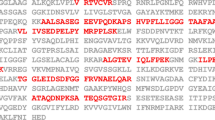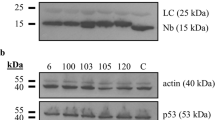Abstract
The E6 proteins derived from tumour associated papillomavirus types target the cellular tumour suppressor protein p53 for ubiquitin mediated degradation. In cell lines derived from cervical tumours the p53 protein is present in very low amounts, but it can be activated by appropriate DNA damaging agents, indicating that functional p53 is present within these lines. Recent studies have also shown that different polymorphic forms of the p53 protein are differentially susceptible to E6 mediated degradation. Therefore we have been interested in analysing the effects of different HPV E6 proteins upon p53 levels in a variety of cervical tumour derived cell lines. We show that inhibition of E6 mediated degradation of p53 frequently results in increased levels of p53 expression. However, there are notable exceptions to this where increased p53 levels are only obtained following DNA damage and proteasome inhibition. We also show in E6 expressing cells, that as well as p53 being targeted for degradation, the localization of p53 to the nucleus is also inhibited, consistent with previous observations which indicate that degradation of p53 is not essential for E6 mediated inhibition of p53 function. These results have important implications for any potential therapies which might aim to block E6 mediated degradation of p53.
This is a preview of subscription content, access via your institution
Access options
Subscribe to this journal
Receive 50 print issues and online access
$259.00 per year
only $5.18 per issue
Buy this article
- Purchase on Springer Link
- Instant access to full article PDF
Prices may be subject to local taxes which are calculated during checkout






Similar content being viewed by others
References
Androphy EJ, Hubbert NL, Schiller JT and Lowy DR. . 1987 EMBO J. 6: 989–992.
Bandara LR, Adamczewski JP, Hunt T and La Thangue NB. . 1991 Nature 352: 249–251.
Banks L, Matlashewski G and Crawford L. . 1986 Eur. J. Biochem. 159: 529–534.
Banks L, Spence P, Androphy E, Hubbert N, Matlashewski G, Murray A and Crawford L. . 1987 J. Gen. Virol. 68: 1351–1359.
Bouvard V, Massimi P and Banks L. . 1996 Int. J. Oncology 8: 159–167.
Butz K, Shahabeddin L, Geisen C, Spitkovsky D, Ullmann A and Hoppe-Seyler F. . 1995 Oncogene 10: 927–936.
Crook T, Morgenstern JP, Crawford L and Banks L. . 1989 EMBO J. 8: 513–519.
Crook T, Tidy JA and Vousden KH. . 1991 Cell 67: 547–556.
Crook T, Parker GA, Rozycka M, Crossland S and Allday M. . 1998 Oncogene 16: 1429–1441.
Davies R, Hicks R, Crook T, Morris J and Vousden KH. . 1993 J. Virol. 67: 2521–2528.
Demers GW, Foster SA, Halbert CL and Galloway DA. . 1994 Proc. Natl. Acad. Sci. USA 91: 4382–4386.
Dyson N, Howley PM, Munger K and Harlow E. . 1989 Science 243: 934–936.
El-Deiry WS, Tokino T, Velculescu VE, Levy DB, Parsons R, Trent JM, Lin D, Mercer WE, Kinzler KW and Vogelstein B. . 1993 Cell 75: 817–825.
Haupt Y, Maya R, Kazaz A and Oren M. . 1997 Nature 387: 296–299.
Huibregtse J, Scheffner M and Howley PM. . 1991 EMBO J. 10: 4129–4135.
Huibregtse JM, Scheffner M and Howley PM. . 1993 Mol. Cell. Biol. 13: 4918–4927.
Knippschild U, Oren M and Deppert W. . 1996 Oncogene 12: 1755–1765.
Kubbutat MH, Jones SN and Vousden KH. . 1997 Nature 387: 299–303.
Lechner MS, Mack DH, Finicle AB, Crook T, Vousden KH and Laimins LA. . 1992 EMBO J. 11: 3045–3052.
Lechner MS and Laimins LA. . 1994 J. Virol. 68: 4262–4273.
Miyashita T and Reed JC. . 1995 Cell 80: 293–299.
Phelps WC, Bagchi S, Barnes JA, Raychaudhuri P, Kraus V, Munger K, Howley PM and Nevins JR. . 1991 J. Virol. 65: 6922–6930.
Pietenpol JA, Tokino T, Thiagalingam S, El-Deiry WS, Kinzler KW and Vogelstein B. . 1994 Proc. Natl. Acad. Sci. USA 91: 1998–2002.
Pim D, Storey A, Thomas M, Massimi P and Banks L. . 1994 Oncogene 9: 1869–1876.
Rock K, Gramm C, Rothstein L, Clark K, Stein R, Dick L, Hwang D and Goldberg A. . 1994 Cell 78: 761–771.
Sakamuro D, Sabbatini P, White E and Prendergast GC. . 1997 Oncogene 15: 887–898.
Scheffner M, Werness BA, Huibregtse JM, Levine AJ and Howley PM. . 1990 Cell 63: 1129–1136.
Scheffner M, Munger K, Byrne JC and Howley PM. . 1991 Proc. Natl. Acad. Sci. USA 88: 5523–5527.
Smotkin D and Wettstein FO. . 1986 Proc. Natl. Acad. Sci, USA 83: 4680–4684.
Stanley M, Browne H, Appelby M and Minson A. . 1989 Int. J. Cancer 43: 672–676.
Storey A, Greenfield I, Banks L, Pim D, Crook T, Crawford L and Stanley M. . 1992 Oncogene 7: 459–465.
Storey A, Massimi P, Dawson K and Banks L. . 1994 Oncogene 11: 653–661.
Storey A, Thomas M, Kalita A, Harwood C, Gardiol D, Mantovani F, Breuer J, Leigh IM, Matlashewski G and Banks L. . 1998 Nature 393: 229–234.
Thomas M, Massimi P, Jenkins J and Banks L. . 1995 Oncogene 10: 261–268.
Thomas M, Matlashewski G, Pim D and Banks L. . 1996 Oncogene 13: 265–273.
von Knebel-Doeberitz M, Oltersdorf T, Schwarz E and Gissmann L. . 1988 Cancer Res. 48: 3780–3786.
Walker KK and Levine AJ. . 1996 Proc. Natl. Acad. Sci. USA 93: 15335–15340.
Werness BA, Levine AJ and Howley PM. . 1990 Science 248: 76–79.
zur Hausen H and Schneider A. . 1987 In: Salzman NP, Howley PM (eds). The papillomaviruses. Plenum Publishing Corp.: New York. pp.245–263.
Acknowledgements
We are extremely grateful to Marcus von Knebel-Doeberitz for the SW756 cells, Guido Manfioletti for the C4-I and Me180 cells, Paola Massimi for help with the immunofluorescence assays and to Miranda Thomas for comments on the manuscript. This work was supported in part by a research grant from the Associazione Italiana per la Ricerca sul Cancro.
Author information
Authors and Affiliations
Rights and permissions
About this article
Cite this article
Mantovani, F., Banks, L. Inhibition of E6 induced degradation of p53 is not sufficient for stabilization of p53 protein in cervical tumour derived cell lines. Oncogene 18, 3309–3315 (1999). https://doi.org/10.1038/sj.onc.1202688
Received:
Revised:
Accepted:
Published:
Issue Date:
DOI: https://doi.org/10.1038/sj.onc.1202688
Keywords
This article is cited by
-
The degradation of Rap1GAP via E6AP-mediated ubiquitin-proteasome pathway is associated with HPV16/18-infection in cervical cancer cells
Infectious Agents and Cancer (2021)
-
Nb-induced stabilisation of p53 in HPV-infected cells
Scientific Reports (2019)
-
Cdk5 phosphorylates non-genotoxically overexpressed p53 following inhibition of PP2A to induce cell cycle arrest/apoptosis and inhibits tumor progression
Molecular Cancer (2010)
-
Elementos víricos y celulares que intervienen en el proceso de replicación del virus del papiloma humano
Clinical and Translational Oncology (2004)
-
Molecular interactions of ‘high risk’ human papillomaviruses E6 and E7 oncoproteins: implications for tumour progression
Journal of Biosciences (2003)



